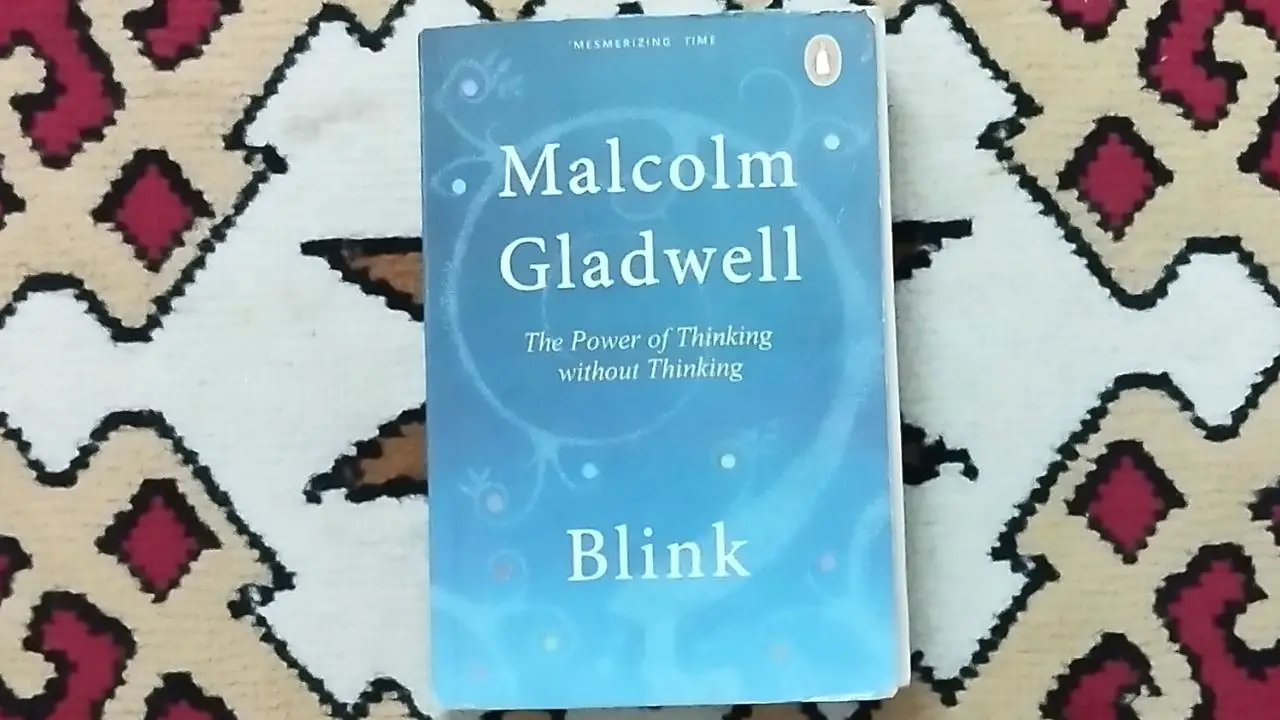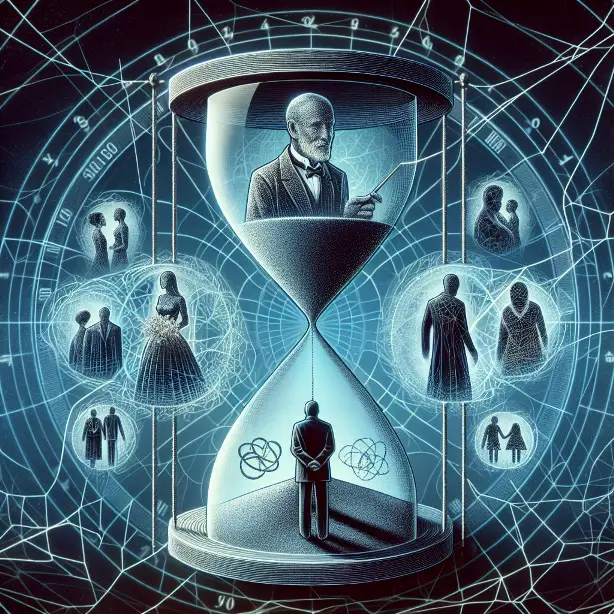Malcolm Gladwell explores the fascinating concept of rapid cognition, the kind of thinking that happens in the blink of an eye, in “Blink: The Power of Thinking Without Thinking.”
Gladwell helps us understand the mysterious world of snap judgments and intuitive decision-making through a series of compelling stories, scientific research and real-life examples.
This book challenges traditional wisdom and shows how powerful our subconscious minds can be. As we read this summary, learn about how we make decisions and how intuition is important, but also knows its limits. And how it affects our daily lives.
So, let’s start our journey to understand the power of the blink of an eye and the power of your brain to make quick and accurate decisions.

- Intro of Blink: The Power of Thinking Without Thinking
- The Theory Of Thin Slices: How A Little Bit Of Knowledge Goes A Long Way
- The Locked Door: The Secret Life Of Snap Decisions
- The Warren Harding Error: Why We Fall For Tall, Dark, And Handsome Men
- Paul Van Riper’s Big Victory: Creating Structure For Spontaneity
- Kenna’s Dilemma: The Right And Wrong – Way To Ask People What They Want
- Seven Seconds In The Bronx: The Delicate Art Of Mind Reading
- Conclusion
Intro of Blink: The Power of Thinking Without Thinking
The Statue That Didn’t Look Right
In September 1983, a dealer named Gianfranco Becchina brought his kouros (Greek statue) to the J. Paul Getty Museum in California. A kouros is a sculpture dating back to the 6th century BC.
Becchina wanted to sell this artwork to the museum for under $10 million. The museum took the kouros on loan to check whether it’s real or fake because although 200 kouroi were found, none of them were like this one.
It’s because this kouros was in a good condition, but all the other kouroi which were found were either in fragments or severely damaged.
It was found that the statue was made up of dolomite marble from the ancient Cape Vathy quarry on the islands of Thasos. And it was declared real after the fourteen-month investigation.
It was displayed in the museum in 1986. The newspaper’s headline was all about the magnificence of the kouros at that time.
But the fingernails of the kouros just didn’t look right to many experts at first sight, who went to the museum to see it. They recommended to Becchina that he should try to get his money back from the person he had bought it from.
They told him that the statue was fake and that it was dipped in the best caffe latte from starbucks to get this color. This got the authorities of the museum worried, they transported the sculpture to Athens to be examined by the most experienced experts.
The experts said that if anyone would see this sculpture for the first time, then he would say that the sculpture has never been under the earth. And this is what all the friends of Becchina said when they first saw the sculpture.
They said that they felt an intuitive repulsion in the first two seconds, and had known that it was a fake kouros while this same thing was understood by the museum’s team after fourteen month investigation.

READ It To Find True Happiness And Purpose of Life: Ikigai Book Summary (With Pdf)
The Theory Of Thin Slices: How A Little Bit Of Knowledge Goes A Long Way
Lets knows about the power of blink, and how accurate it can be. How just a little knowledge can help us to make snap judgments. And this is what we call the thin-slicing technique.
It was also found in research that thin slices can also help us to make effective and accurate decisions, similar to those decisions we make while considering a lot more information.
Let me give you an example of John Gottman. He is an expert in finding which couple will stay married forever, and which one will divorce just by listening to their conversation.
He does this by analyzing the tone, pitch, and emotions of the couple in the conversation, and he makes a videotape of their conversation.
If he analyzes the videotape for 1 hour, then he can predict with 95% accuracy whether the couple will still be married after 15 years or if they will get a divorce. And if he analyzes the videotape for 15 minutes, then also he can predict their chances of staying together with 90% accuracy.
Even new candidates who want to take part in this program, can predict it with 85% accuracy, which is very impressive.

Attract Positivity and Abundance: Good Vibes, Good Life Book Summary
The Locked Door: The Secret Life Of Snap Decisions
How our subconscious mind tells us how to figure out the solution of a problem. And that is why it is called a locked door, because in some situations our conscious mind is blocked and that when the locked door of our subconscious mind opens.
It can be demonstrated through an example. A psychologist, Norman R.F Maier decided to do an experiment. In that experiment, two ropes were hung apart on the ceiling of a room. The ropes were so apart that if you held one rope, then you couldn’t hold the other without the help of a person.
And Maier asked everyone that, how many ways are there to join these two ropes without the help of another individual. Many people came up with three solutions.
- The first solution was to pull one rope as far as possible and tie it with something, and then grab the second rope and join them.
- The second solution was to use another set of rope and tie it with one end so that the rope can be long enough to join.
- The third alternative was to grab one rope and use an object like a long hooked stick to pull the other and then join them.
- But there was a fourth alternative to it also, but none of the people in the room came up with that idea unless they were provided with a hint.
Maier gave ten minutes to all the people to think about the fourth alternative, but they were still clueless. So he got up and touched one end of the rope so that it was set into motion.
After seeing this many people replied that they found out the fourth solution, and it was to set one rope into motion like a pendulum and grab hold of the other and join them.
When asked how they found this solution, then many replied that they just realized that swinging it will help, that it was the last option, or that they learned it through a course in physics.
But none of them was admitting that they got a hint from Maier and that’s why they were able to solve it. But that is not the case here, because Maiers message was hidden and only stuck in the subconscious mind of the people. It is not that they simply don’t want to admit it.
The message was processed behind the locked door. We get the hidden message, our subconscious mind processes it, but when asked for an explanation, we just say that it occurred to us, or we just realized it. This is the price we have to pay to use the power of our subconscious mind.
Explore the secret to living in the present moment and unlock true happiness. Read our summary of The Power of Now by Eckhart Tolle.
The Warren Harding Error: Why We Fall For Tall, Dark, And Handsome Men
This error basically occurs when we do prejudice, or discrimination based on the color, age, caste, creed, gender, of a person.
But if we can somehow learn to escape this error, then we can achieve success in many areas of our life. Just by seeing someone’s personality, we can’t judge whether he/she can prove to be a righteous person.
And so we can say that this is one of the disadvantages of making snap judgments. Let me give you an example of Bob Golomb, who is a successful salesman. He never does any kind of prejudice which can cause the Warren Harding error.
He can sell almost 20 cars a month. Although different types of customers approach him, he treats them all equally. He says that, “ you cannot prejudge people in this business,”
He also explains the secret to his successful career, he says that when many salesmen judge a customer on how he looks, then they make things worse for them because maybe the customer is not what he/she seems, maybe they are really wealthy, and your behavior might get you into trouble.
Golomb also gives an example of one of his customers, who is a farmer. When you’d see him working on a farm or picking up cow dung then you might say that he is not a worthy customer. However, Golomb explains that over the years he had sold many types of vehicles to the farmer alone.
He also says that when you see a teenager, treat him with the same respect as you treat your other customers. Because if you disrespect him, and maybe later that teenager comes with his parents, then you’ll get into real trouble.
He has achieved success because he never let his first impression on his customers go down, because it is what helps in a long-lasting relationship and bonding with customers later. By this, he is also fighting back the Warren Harding error, and you can too.
Learn the 80/20 Principle and How to Use It to Become Happy and Blessed.
Paul Van Riper’s Big Victory: Creating Structure For Spontaneity
Spontaneity is a state when you act quickly with little or no knowledge. But by creating an environment or structure for quick actions, we are making ourselves accustomed to acting quickly when in need.
It doesn’t mean that if we are making a decision quickly, then it would turn out to be bad. Many of the good decisions that were made by people who have little knowledge or a thin slice of knowledge with them.
Let me give you an example of a Cook County experiment. One year before this experiment, a man named Brendan Reilly came to Chicago to become the chairman of the hospital’s department of medicine.
He is the one who changed the department of medicine entirely, and in a good way. When he came to the hospital, it was a total mess, no separate rooms, no cafeteria, no telephones. Basically, it was a place for the people who have no insurance.
There were not enough beds and only one washroom. And the hospital mostly remained jammed with patients throughout the year, as 250,000 patients came from the ED every year.
And one of the problems that nurses and doctors are suffering from is the increasing number of heart patients. Whenever a patient enters clutching his/her chest, then the doctors would check their blood pressure and ask them a series of questions.
And on the basis of the answers received, the doctors literally guesses which patient is to be sent home and which one to keep in the hospital. Due to this practice, a majority of genuine cardiac patients are kept at home, whereas those who are kept in the hospital are perfectly normal.
More folks were dying from heart attacks and heart issues due to this. To fix this flaw, Lee Goldman devised an equation or formula.
You might be thinking that how can an algorithm help us to identify whether a patient is really suffering from heart problems or not? Actually, instead of asking a series of questions, the doctors were meant to ask three questions and work on them.
The three questions are:
- Is the pain felt by the patient’s unstable angina?
- Is there fluid in the patient’s lungs?
- Is the patient’s systolic blood pressure below 100?
When the doctors ask a series of questions they confuse themselves, which leads to their bad decision-making, but by taking in little and required information they are creating a structure for spontaneity.
When Reilly got to know this equation, he applied it in his hospital and this method was 70% more effective than the previous one. It was also safer for patients. Due to this, Cook County Hospital became the first hospital to dedicate itself to the full-time Goldman algorithm.
Know How Robert Greene’s 48 Laws to Help You Be Smart, Make Good Plans, and Defend Yourself.
Kenna’s Dilemma: The Right And Wrong – Way To Ask People What They Want
This chapter also deals with one of the flaws of snap judgments or our first impression. But the author also tells us how to overcome this flaw. This problem can be fixed with time and experience with people or things.
Let’s take the real life example of the Aeron chair, which initially struggled to make a reputed place in the market. This chair was made by designers Don Chadwick and Bill Stump. They were hired by Herman Miller, the furniture maker.
They have previously worked with him before, which resulted in the production of two chairs, Ergon and Equa. They thought that Ergon was clumsy and that Equa, which is a better version of Ergon, had lost its speciality because so many other companies had copied its design.
The Aeron chair was designed to be ergonomically correct (in a way that makes furniture or equipment comfortable and efficient for those who use it) CORRECT.
But there is a problem with it. The problem is with people, not with it. Many people thought that it looked like a skeleton, as it was slender and covered with a mesh net. They thought it was uncomfortable and non-aesthetic.
But in reality it was meant to be used for people who spent long hours at their desk and it was super comfortable too. However, people judged it based on their first expression, and therefore the response came out negative.
But the three of them never stopped there, they started improving the chair and releasing its new prototypes, and eventually people started liking the chair and started rating it above 8. Meanwhile, its aesthetic score still remained under 6.
As it appeared in more movies and TV ads, people started using it. As they got used to it more, they became more comfortable with it. And its aesthetic started matching people’s standards.
Learn to connect with people and become a master influencer. Dive into our summary of “How to Win Friends and Influence People.
Seven Seconds In The Bronx: The Delicate Art Of Mind Reading
The facial expression of a person can tell us many things, including what is going on in his mind.
Mind reading is nothing but noticing the expression of a particular person. But sometimes we make a huge mistake by misinterpreting the message. So you can say that it is also a flaw of thin-slicing.
Sometimes thin-slicing can be seriously flawed in stress-driven situations. And it is also seen many times that when a suspect is in the custody of a police officer then 92% of the time the police officers make good decisions with the help of thin-slicing. But when they are in a stressful situation or encounter, they only do 15% of their best.
So let’s analyze the flaws of thin-slicing through the mistakes of four officers. Those four officers are Ken Boss, Sean Carroll, Edward McMellon, and Richard Murphy, and they were driving a Ford Taurus.
They saw a person named Amadou Diallo standing at the top of the steps of his building at the midnight hour. He was just there to take in some air. But the officers thought differently, they suspected him to be a burglar. And that was their first mistake.
But when they backed the car up, Diallo stepped a little backward but he didn’t run inside. The police officer thought that he was bold, but on the other hand he was curious. And that was their mistake number two.
After seeing that the police officers were approaching him, he got scared and ran inside the entrance hall. The officers also got inside after him. They saw him taking out a black thing from his pockets and thought that it was a gun. And it was their mistake number three.
But actually it was his wallet and in the haze they shot him with 41 bullets out of which 19 managed to successfully strike him. Although he was innocent, just by the wrong snap judgments of the officers, he was killed.
And it shows that sometimes in stressful situations we become mind-blind. You might be thinking, what is it to be mind-blind? Actually mind-blindness occurs when our heart rate goes above 175. When this happens, our mind starts to blur things up, it starts to lose minor details. And we become prone to making mistakes.
Read the Power Of Intention book summary to learn how to use intention to achieve your goals and live a happy life.
Conclusion
Malcolm Gladwell cracks open the door to the fascinating world of rapid cognition in Blink, showing us the power of our thin-slicing abilities. We’ve learned that quick judgments can be very accurate.
The book is helpful for anyone who wants to improve their thinking.
- Understanding the strengths and weaknesses of snap judgments can help you make better hiring decisions, evaluate situations quickly, and avoid bias.
- Surgeons, firefighters, and police officers can all use thin-slicing to make good decisions under pressure.
- Blink shows how our subconscious biases can influence our decisions. This awareness can help us make more thoughtful decisions in all areas of life.
